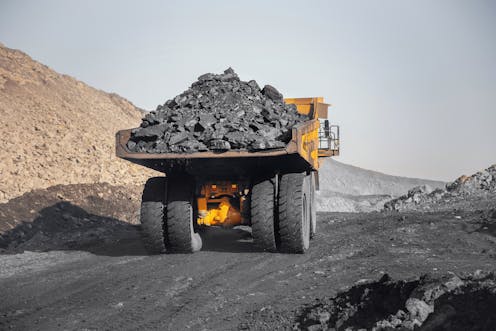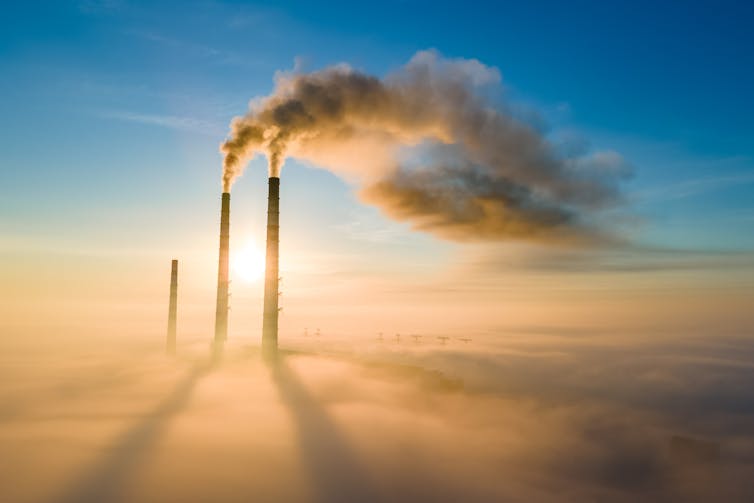Source: The Conversation (Au and NZ) – By Simon Campbell, Senior research fellow and lecturer, Monash University

Shutterstock
This year, the Australian government rejected Clive Palmer’s coal mine proposal – but approved three others. Over 100 more fossil fuel projects are in the decision pipeline.
Why are we still approving coal projects when climate impacts are intensifying? There is, as the International Energy Agency has pointed out, no place for new fossil fuels if we have a chance of holding global heating to 1.5℃ above pre-industrial levels. Our existing fossil fuel infrastructure is enough to blow our remaining carbon budget.
Unusually, Environment Minister Tanya Plibersek and her department were required to account for climate impacts in a recent decision.
They decided the climate effects did not have “relevant impact”. One of the key reasons they gave for this was that the emissions from burning the coal from a single mine will, they claim, have a “very small” impact on warming – just 0.00024℃ over the lifetime of the mine.
As a physicist, this argument does not stack up. What seems like a minuscule amount of warming to a politician is, to scientists, very concerning. It’s no wonder environmental organisations are filing lawsuits to try to stop these mines.

Shutterstock
One new mine is the same as millions of nuclear bombs of heat
Right now, Plibersek and her department are weighing up final approval for the expansion of the Mount Pleasant coal mine in New South Wales’ Hunter Valley. If approved, it would let the mine’s owners MACH Energy Australia double its extraction rate to 21 million tonnes of coal per year.
So far, the project has breezed through environmental approvals. But how can Australia’s environment minister reason that new coal mines won’t do too much damage to the climate?
Plibersek gives two main arguments. One is the assumption that if we don’t dig up fossil fuels, someone else will. Known as “the drug dealer’s defence”, this rationale has been rejected in a growing number of fossil fuel court cases, for example in in NSW, Queensland and the United States.
The second – the “very small” impact on warming – is worth a closer look.
By the mining company’s calculation, the expanded project will add 535 million tonnes of carbon dioxide equivalent (CO₂e) to our atmosphere over the lifetime of the mine. That’s about a year’s worth of Australia’s entire domestic emissions.
The department took this CO₂e figure and estimated how much this would change Earth’s global temperature. That’s where they got the “very small” figure of 0.00024℃.
Read more:
Earth’s energy budget is not in balance. Should we be concerned?
To a politician, this small number may seem insignificant. But to a physicist it is truly remarkable. What it actually means is we are able to alter an entire planet’s temperature with this single mine extension.
Changing a planet’s temperature takes an enormous amount of energy.
If it weren’t for the greenhouse effect, Earth would be too cold for life. The problem is humans have been steadily increasing the amount of greenhouse gases in the atmosphere, causing Earth to retain more and more of the Sun’s vast energy, heating the planet to dangerous levels.
Burning fossil fuels is responsible for most of this.
Our planet is now warming at a rate of 0.018℃ per year.
If we compare that to the department’s figure of 0.00024℃, we see the total warming effect from the Mount Pleasant mine would be about 1.3% of one year’s global warming.
Doesn’t sound like much? Consider this. Human activity is causing about 7.8 zettajoules of extra heat to be added to the Earth’s climate system every year. So, 1.3% of a year’s global warming gives roughly 0.1 zettajoules worth of extra heat through burning the output of an expanded Mount Pleasant coal mine.
Now, a zettajoule is 1,000,000,000,000,000,000,000 joules of energy. This number is so large we can’t relate to it. We can think of it instead as around 1.7 million Hiroshima bombs worth of extra heat. From one single mine extension.
So, it is not a “very small” amount of energy. And that’s just one mine. If the 25 proposed new coal mines and three recently approved projects go ahead, they would add 12,600 million tonnes of CO₂ emissions to the atmosphere. That, in turn, would trap heat equivalent to roughly 43 million Hiroshima bombs. And this doesn’t even count the planned gas and oil projects, or projects approved at the state level.
We can’t claim we don’t know
New fossil fuel project approvals at a time when global heating is accelerating seem like a remarkable disconnect.
It’s for this reason we’re seeing a spike in climate lawsuits. The Environment Council of Central Queensland is taking Plibersek to court, aided by Environmental Justice Australia.
Central to their case will be the claim the minister acted unlawfully when she “refused to accept the climate harm these projects are likely to cause, as outlined in thousands of scientific reports, including from the IPCC and her own department.”
The lawsuit has stopped the Mount Pleasant extension and Whitehaven’s Narrabri mine from proceeding further until the case has been heard.
We can’t predict the outcome of the case – it could go either way.
But we can predict the outcome of new fossil fuel projects. Dig up coal, burn it, heat the planet. We can’t argue our way out of the laws of physics.
![]()
Simon Campbell receives funding from the Australian Research Council. He is affiliated with Australian Parents for Climate Action (AP4CA).
– ref. What harm could one coal mine do? Plenty, producing 1.7 Hiroshima bombs of heat – https://theconversation.com/what-harm-could-one-coal-mine-do-plenty-producing-1-7-hiroshima-bombs-of-heat-210384







